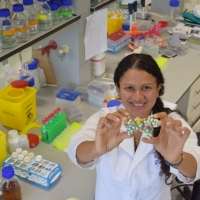Proteins hiding in proteins take an evolutionary shortcut

How a drug-like protein ring evolved in sunflowers has been pieced together by Australian and US scientists in a study published in Molecular Biology and Evolution. Although the evolutionary process took some 45 million years, the researchers are still calling it a shortcut.
The study team included researchers from the University of Western Australia; La Trobe University in Melbourne, the University of Tennessee and the University of Texas.
Team leader Dr Joshua Mylne, principal investigator with UWA's School of Molecular Sciences and affiliated to the national ARC Centre of Excellence in Plant Energy Biology, said the team used an unprecedented volume of DNA sequence information to document the evolution of an unusual family of plant proteins.
Lead author Dr Achala Jayasena, who has just completed her PhD at UWA, said researchers were interested in a small but potent digestion-blocking molecule from in sunflower seeds called SFTI.
"What makes SFTI unusual is that its sequence is buried inside a completely different protein that acts like a host," Dr Jayasena said.
"By sequencing all the genes in seeds from over 110 species related to sunflower we were able to classify different gene types that make SFTI or related products. Coupling this to information from evolutionary trees made by our collaborators in the US allowed us to date when certain gene types appeared.
"The digestion-blocking SFTI took 45 million years to evolve inside its host. The first evolutionary step was a short DNA sequence that makes a tiny circular protein. By 34 million years ago the protein had become bigger and flatter.
"Then about 23 million years ago some of these bigger and flatter proteins were able to block digestive enzymes and this property has been retained to present day in dozens of species including the common sunflower.
"What we've done is document the evolutionary steps that this small protein ring underwent to reach its current day form and function.
"While tracing the history of SFTI, to our delight, we discovered the first few members of what looks like a new class of cyclic proteins that are even smaller than SFTI."
Dr Mylne said although assembling entire RNA libraries of 40,000 or more genes only to search them and follow a handful of genes seemed overkill, like swatting a fly with a sledgehammer, the plummeting cost of sequencing actually made it worthwhile.
"Not only does the RNA library approach show you where your gene is, but it also gives you an idea where it isn't – and that's useful information too," Dr Mylne said.
"This is the first time anyone has been able to document how a protein can appear stepwise inside an unrelated protein host. Although it took some time, making a new protein inside an existing gene is an evolutionary shortcut.
"The way this protein evolved inside another protein host has us wondering if this shortcut is a universal phenomenon shared by plants, fungi, animals and bacteria. If so there will be other examples out there waiting to be discovered. That these peptides are stable and bioactive has us hoping that other examples will similarly make useful molecules."
More information: Achala S. Jayasena et al. Stepwise evolution of a buried inhibitor peptide over 45 million years, Molecular Biology and Evolution (2017). DOI: 10.1093/molbev/msx104
Journal information: Molecular Biology and Evolution
Provided by University of Western Australia


















